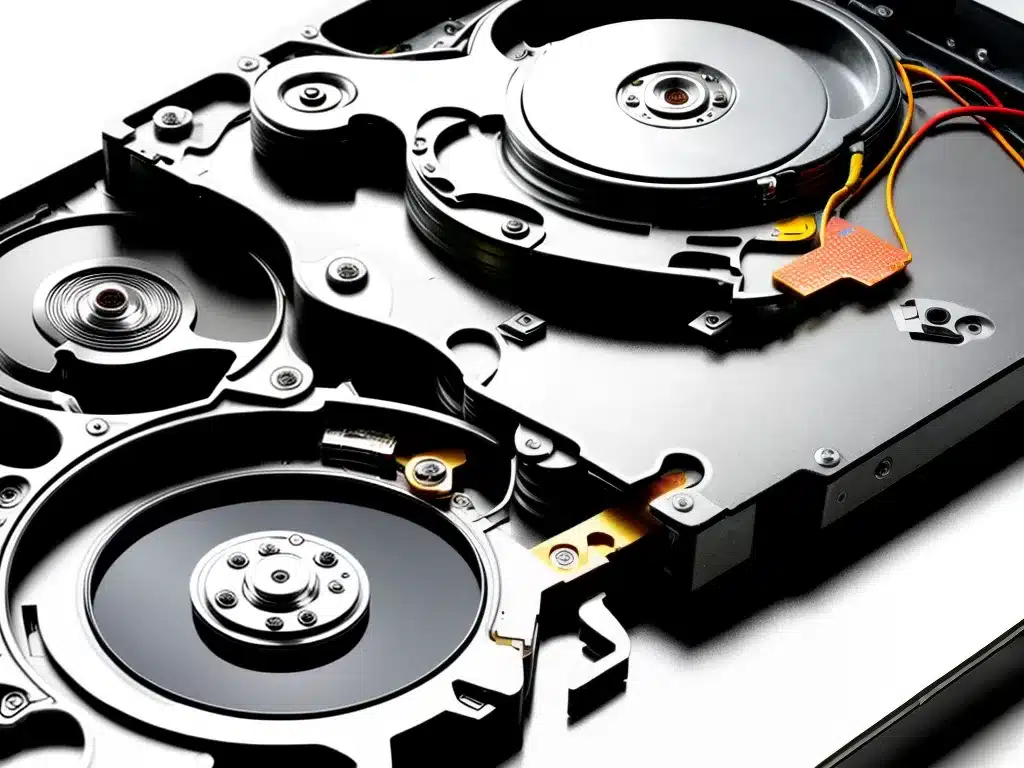What Causes Hard Drive Noise?
Hard drives can make noises like clicking, buzzing, grinding, squeaking, knocking, or humming for a variety of reasons. Here are some of the most common causes of a noisy hard drive:
Mechanical Failure
- Bearings – Worn or failing bearings in the drive’s spindle motor can cause squealing/screeching noises as they start to bind.
- Head actuator – If the head actuator mechanism is worn or stuck, it can cause buzzing/grinding noises as it moves across the platters.
- Platters – If the hard drive’s platters are damaged or warped, they can vibrate and cause rhythmic humming/whining noises.
Impact Damage
- Shock/vibration – If a hard drive receives a heavy shock or is subject to excess vibration, internal components can become misaligned and make contact, causing buzzing/grinding noises.
Electrical Failure
- Motor – If the spindle motor has electrical problems, it may make humming/squealing noises as it struggles to spin up the platters.
- Circuitry – Electrical issues on the controller board can produce clicking/buzzing noises.
Diagnosing the Source of Hard Drive Noise
Pinpointing exactly where the noise is coming from inside a hard drive is key to determining the root cause. Here are some tips for diagnosing hard drive noise issues:
Isolate the noise
- Carefully listen to identify recurring patterns, frequencies, and intensities of the noise. Write down your observations.
- Remove nearby components that could vibrate sympathetically, like fans or optical drives.
- Test the drive in another system, if possible. If noise disappears, issue is with original system.
Recreate the noise
- Attempt to trigger the noise by doing hard drive operations like booting up, loading programs, reading/writing data.
- Try tapping on the drive casing while powered off to induce noises.
Open the drive (with caution)
- Warning: Opening up a hard drive voids the warranty and can damage it if not done properly.
- If the above steps don’t isolate the noise, carefully open the hard drive in a dust-free environment.
- Visually inspect and touch internal components to feel for vibrations as you recreate the noise.
Common Hard Drive Noise Repairs
If you’ve diagnosed the source of the noise, here are some possible DIY fixes:
Fix physical damage/alignment
- Replace worn bearings or realign platters if damaged.
- Reseat connectors between controller PCB and drive chassis.
Replace drive components
- Swap out defective head actuator or spindle motor with matching used spare parts.
Adjust drive firmware
- Update firmware or configure settings to reduce unnecessary head movements/seeks.
Electrical repairs
- Resolder loose connections between controller board and connectors.
- Replace failed electronic components on logic board.
Try acoustic damping
- Place adhesive rubber pads/bumpers on drive case to absorb vibration.
- Suspend drive in elastic cords to isolate from case vibration.
Secure drive properly
- Make sure drive is firmly attached in system and cannot wobble/vibrate.
- Use rubber grommets/screws to reduce transfer of vibration.
When to Seek Professional Hard Drive Repair
If you don’t feel comfortable attempting a DIY hard drive noise repair, seek help from a professional recovery service when:
- The drive has critical data that cannot be risked.
- The noise indicates mechanical failure of internal components.
- You don’t have a clean room to safely open the drive.
- The drive has encrypted data.
A specialist with the right tools and environment can repair drives non-invasively, rescue data, and perform platter/head transplants in severe cases. This gives you the best chance of recovering data and restoring operations.
Preserving Your Data
To avoid losing critical data due to a failing noisy hard drive:
- Maintain good ventilation around hard drives to prevent overheating.
- Use anti-vibration mounts and secured drive bays.
- Be careful not to bump/drop external hard drives.
- Back up your data regularly to a separate storage device or cloud service.
By understanding the root causes of hard drive noise, diagnosing issues promptly, and utilizing professional recovery services when needed, you can get back to normal operation quickly while keeping your important data safe. Let me know if you have any other questions!













